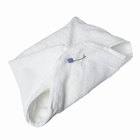Wetsuits are frequently made of neoprene, but for swimmers allergic to the product this can be a real problem. Another downside is the manufacturing process used to create this synthetic rubber can be harmful to the environment. Alternatives are available, and most claim to be more environmentally friendly and equally insulating. They show up in other products too such as koozies and laptop covers.
Ariaprene
Ariaprene is advertised as an environmentally friendly, nontoxic alternative to Neoprene that will be less likely to cause allergic reactions. John Whyte, Vice President of sales for Ariaprene, says the product is a better and lighter insulator than Neoprene. Neoprene's rubber-based material can only come in black or white while Ariaprene is available in multiple colors, he says. In addition, Ariaprene is recyclable and biodegradable.
Plant-Based
Patagonia, a company that sells surf and sports apparel, has a neoprene-alternative wetsuit made from 60 percent guayule. Guayule, a flowering shrub, needs only a little water to grow. Jason McCaffrey, surf director for Patagonia, says the company also offers a wetsuit made from 100 percent guayule. The material, he told Transworld Business in 2012, is stretchier than neoprene, insulates just as well, and smells like pine.
Neogreene
GreenSmart's Neogreene is a foam that it claims is more environmentally friendly than the foam for traditional neoprene. The company says it's made from a secret thermoplastic formula. Unlike neoprene, it has no chlorine, no metals and no pthtalates. Manufacturing the product requires 25 percent less energy and petroleum than neoprene. According to GreenSmart's website, this alternative is waterpoof like neoprene, just as durable, lighter weight and a better insulator.
Thermocline
Thermocline, produced by Fourth Element, advertises itself as an option for people allergic to neoprene. It's also marketed to travelers because it's light and easily folded. The suit on its own isn't supposed to keep people as warm as a neoprene suit. However, some people might wear a thermocline suit under their neoprene suit so its fabric doesn't touch their skin.
Related Articles

The Advantages of Wool Clothing

What Is the Difference Between Lycra ...

What Is a Textile Motorcycle Jacket?

Cordura Vs. Leather

The Difference Between Polartec and ...

The Different Fabrics of Raincoats and ...

Types of Burberry Plaid

The Differences of Neoprene & Thinsulate

The Advantages of Polyester Cotton

The Differences Between Fleece & ...

What Is Fleece Fabric Made From?

Microfleece Vs. Microplush

How to Shrink a Baseball Jersey

Thinsulate Vs. Thermolite

Uses of Cotton Fabric

Differences Between Under Armour ...

How Does Cotton Help Insulate?

Is Revere Ware Aluminum?

How to Dress Like Travis Barker

The Difference Between Brown and White ...
References
Resources
Writer Bio
With features published by media such as Business Week and Fox News, Stephanie Dube Dwilson is an accomplished writer with a law degree and a master's in science and technology journalism. She has written for law firms, public relations and marketing agencies, science and technology websites, and business magazines.